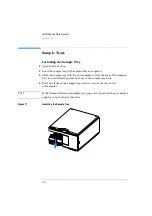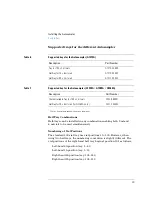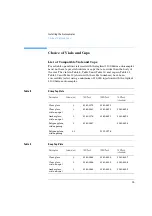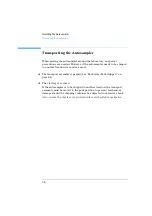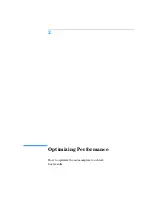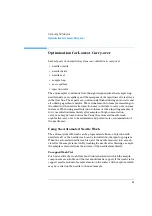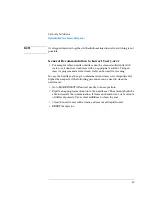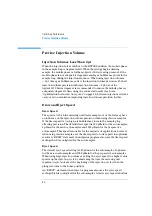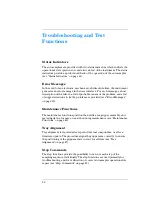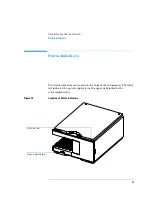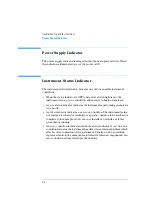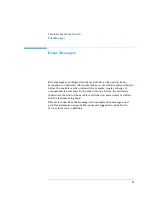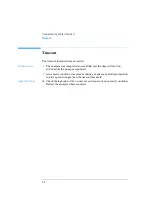
46
Optimizing Performance
Precise Injection Volume
Precise Injection Volume
Injection Volumes Less Than 2 µl
When the injection valve switches to the BYPASS position, the mobile phase
in the sample loop is depressurized. When the syringe begins drawing
sample, the mobile phase is further subjected to decreasing pressure. If the
mobile phase is not adequately degassed, small gas bubbles may form in the
sample loop during the injection sequence. When using injection volumes
< 2 µl, these gas bubbles may affect the injection-volume precision. For best
injection-volume precision with injection volumes < 2 µl, use of the
Agilent 1100 Series degasser is recommended to ensure the mobile phase is
adequately degassed. Also, using the automated needle wash (see
“Optimization for Lowest Carry-over” on page 41) between injections reduces
carry-over to a minimum, improving injection-volume precision further.
Draw and Eject Speed
Draw Speed
The speed at which the metering unit draws sample out of the vial may have
an influence on the injection volume precision when using viscous samples.
If the draw speed is too high, air bubbles may form in the sample plug,
affecting precision. The default draw speed is 200 µl/min for the autosampler,
4 µl/min for the micro autosampler and 1000 µl/min for the preparative
autosampler. This speed is suitable for the majority of applications, however,
when using viscous samples, set the draw speed to lower speed for optimum
results. A “DRAW” statement in an injector program also uses the draw speed
setting which is configured for the autosampler.
Eject Speed
The default eject speed setting is 200 µl/min for the autosampler, 10 µl/min
for the micro autosampler and 1000 µl/min for the preparative autosampler.
When using large injection volumes, setting the eject speed to a higher value
speeds up the injection cycle by shortening the time the metering unit
requires to eject solvent at the beginning of the injection cycle (when the
plunger returns to the home position).
An “EJECT” statement in an injector program also uses the eject speed
setting which is configured for the autosampler. A faster eject speed shortens
Содержание G1313A
Страница 1: ...s1 Agilent 1100 Series Standard Micro and Preparative Autosamplers Reference Manual ...
Страница 3: ...Reference Manual Agilent 1100 Series Standard Micro and Preparative Autosamplers ...
Страница 12: ...12 Contents ...
Страница 39: ...2 2 Optimizing Performance How to optimize the autosamplers to achieve best results ...
Страница 49: ...3 3 Troubleshooting and Test Functions The modules built in troubleshooting and test functions ...
Страница 93: ...93 Troubleshooting and Test Functions Step Commands ...
Страница 159: ...5 5 Parts and Materials Detailed illustrations and lists for identification of parts and materials ...
Страница 160: ...160 Parts and Materials Main Assemblies Main Assemblies Figure 19 Autosampler Main Assemblies 5 3 4 2 1 9 8 7 6 ...
Страница 166: ...166 Parts and Materials Analytical Head Assembly Figure 21 Analytical Head Assembly 2 3 4 5 6 1 ...
Страница 191: ...191 Parts and Materials Remote Cables NOTE START and STOP are connected via diodes to pin 3 of the 3394 connector ...
Страница 216: ...216 Introduction to the Autosampler Electrical Connections ...
Страница 217: ...7 7 Theory of Operation Theory of operation of mechanical hardware electronics and instrument interfaces ...
Страница 244: ...244 Theory of Operation The Main Power Supply Assembly ...
Страница 265: ...265 Introduction to the Control Module Diagnostics and Tests ...
Страница 268: ...268 Introduction to the Control Module Diagnostics and Tests ...
Страница 269: ...9 9 Specifications Performance specifications of the Agilent 1100 Series Standard Micro and Preparative Autosamplers ...
Страница 274: ...274 Specifications Performance Specifications ...
Страница 275: ...10 Legal Safety and Warranty Information ...
Страница 286: ...286 Agilent Technologies on Internet ...
Страница 290: ...290 Index ...
Страница 291: ......

